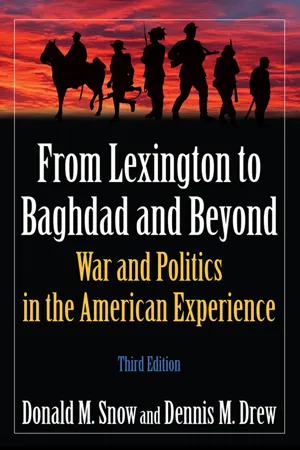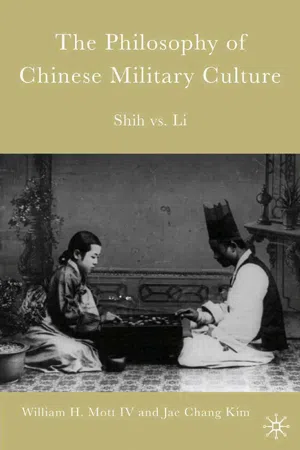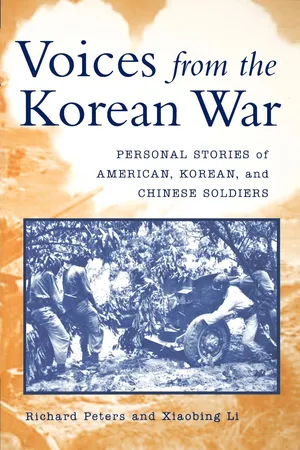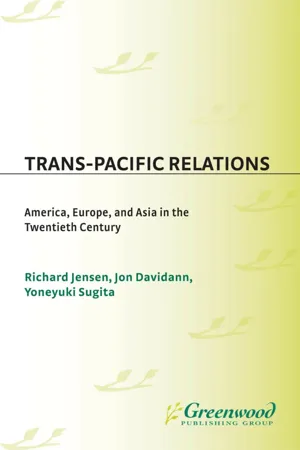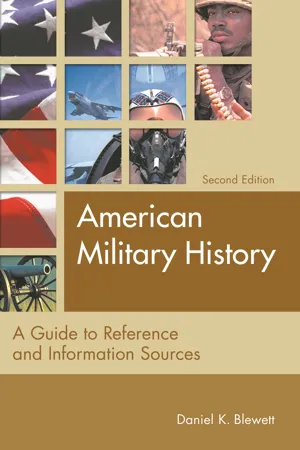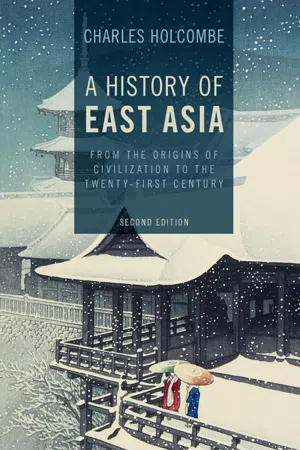History
The Korean war
The Korean War was a conflict between North Korea, supported by China and the Soviet Union, and South Korea, supported by the United Nations and the United States. It began in 1950 when North Korean forces invaded South Korea, and ended in 1953 with an armistice, but no formal peace treaty. The war resulted in the division of Korea into North and South.
Written by Perlego with AI-assistance
Related key terms
1 of 5
11 Key excerpts on "The Korean war"
- eBook - PDF
Secret Wars
Covert Conflict in International Politics
- Austin Carson(Author)
- 2018(Publication Date)
- Princeton University Press(Publisher)
142 5 The Korean war (1950–1953) Two decades after the Spanish Civil War and only five years after World War II, conflict between North and South Korea threatened to again plunge the wider international system into war. The Korean war, fought from 1950 to 1953, grew to include multiple outside interventions. Yet despite Soviet, American, and Chinese combat participation, the war was successfully limited to the Korean peninsula. This chapter focuses on the covert side of The Korean war, showing how escalation control drove leaders to embrace covert behavior and collude when detecting it. This limited war, in turn, became a key reference point for the future encounters in the Cold War. The Korean war would become the paradigmatic case of how great powers in the atomic age could successfully limit war.1 How force was used on both 1 Robert Jervis, “The Impact of The Korean war on the Cold War,” Journal of Conflict Reso-lution 24, no. 4 (December 1, 1980): 578–84; John Lewis Gaddis, The Cold War: A New History (New York: Penguin Group (USA), 2005), 50–65; Yuen Foong Khong, Analogies at War: Korea, Munich, Dien Bien Phu, and the Vietnam Decisions of 1965 (Princeton, NJ: Princeton University Press, 1992). Smoke describes the influential concepts of “a war arena and of geographic sanctu-aries,” important for later Cold War encounters, as specifically emerging from The Korean war. Examples of such sanctuaries in The Korean war include Western use of force near and over the Yalu River and the Chinese and Soviet refusal to endanger American military assets in Japan. - eBook - PDF
Unequal Partners in Peace and War
The Republic of Korea and the United States, 1948-1953
- Jongsuk Chay(Author)
- 2002(Publication Date)
- Praeger(Publisher)
In terms of location and sacrifice, the war was definitely Korean. On the other hand, in terms of resources—both human and material—and the control-command factor, the war was international. If one step further is taken, then the international component can be narrowed down to two major antagonists, the United States and the Soviet Union. The Russians provided The Outbreak of the War 185 supplies and equipment and an element of control. In contrast, the Ameri- cans provided a fighting force, in addition to supplies, equipment, and an element of control. As a result, the war was essentially a struggle between these two great powers. The Korean war as such is thus wrongly named. Korea provided the stage for the action and the sacrifice, and the two great powers were the major actors; therefore, it should be called the Korea War. The Korean war was much less Korean than the Vietnam War was Viet- namese. 20 In retrospect, it seems that The Korean war, part of the Cold War which impregnated the whole world in the latter part of the twentieth century, was very difficult to avoid, and a special mechanism and some very special efforts were needed for its avoidance. Since Soviet leaders had a clearer idea about the peculiar geopolitical characteristics of the Korean peninsula as a buffer zone, if the American leaders had had an equally adequate un- derstanding of the special nature of the peninsula, the unfortunate division at the 38th parallel might have been avoided. Once a dynamic entity such as a nation was artificially divided, a natural force began to operate for its restoration. The fusion, however, did not have to be violent; it could have been a peaceful one. To monitor the process peacefully, power equilibrium or a moderating mechanism was necessary. But instead of such a mecha- nism, the world provided Korea with a fierce ideological struggle between communism and liberal democracy. To overcome the added difficulty, a special human effort was necessary. - eBook - PDF
America in the World
A History in Documents since 1898, Revised and Updated
- Jeffrey A. Engel, Mark Atwood Lawrence, Andrew Preston, Jeffrey A. Engel, Mark Atwood Lawrence, Andrew Preston, Mark Lawrence, Jeffrey A. Engel, Andrew Preston(Authors)
- 2023(Publication Date)
- Princeton University Press(Publisher)
8 The Korean war and the Cold War of the 1950s The Cold War took an ominous turn in 1950. Open hostilities erupted on the Ko- rean Peninsula, which had been split at the thirty-eighth parallel at the end of World War II. Troops and tanks from the communist north poured into the pro- Western south. What many historians interpret today as a civil war between Kore- ans immediately appeared to policy makers around the world, and in Washington in particular, as part of a global communist assault orchestrated by Beijing and Moscow. American policy makers responded with force, vowing to defend the south- ern regime, while plotting as well a long-term evolution of American society and military planning capable of defeating the global communist threat over time. They soon split over exactly how much force they might best employ in Korea and beyond. President Harry S. Truman in particular wanted South Korea liber- ated, but not at the cost of a broader war in Asia against Chinese and Soviet troops. Others, most notably the American commander in the region, General Douglas MacArthur, believed there should be no limits on the American war efort against global communism. This clash between Truman and MacArthur became one of the signature moments in the struggle between civilian and military control of American war making in the nation’s history. The struggle also encapsulated the broad questions of the 1950s for American policy makers: how much was enough to secure American interests and Washington’s allies, and how much—in defense spending, domestic surveillance of communist threats, or the size of government itself—would undermine the very freedom they hoped to defend. At the moment MacArthur lost his job for too often and too vocally endorsing a wholesale assault on communism, including perhaps even the use of atomic weapons, Truman’s White House embraced the National Security Council’s NSC-68, a global blueprint for vastly expanding the national security state. - eBook - ePub
From Lexington to Baghdad and Beyond
War and Politics in the American Experience
- Donald M Snow, Dennis M. Drew(Authors)
- 2015(Publication Date)
- Routledge(Publisher)
6KOREAN WARIf World War II had been the ultimate example of total war, the Korean conflict began the trend back to limited engagement. Begun a mere five years after the conclusion of the Second World War, Korea started a process of adjustment for American military and political leaders. It is a process of understanding and interaction that still continues.The Korean war was a new experience for the United States and for the international order that emerged from the ashes of World War II. For the United States, the experience was unique in at least three ways. First, it was our first limited war in modern (twentieth-century) times. As such, it represented a discontinuity in experience that required painful learning and adjustment. Second, it was the first significant cold war confrontation and represented a novel challenge to the emerging American role in the world. Third, it was the first major American military engagement not preceded by a formal declaration of military intent by the Congress of the United States, and it began a constitutional and political process that culminated in the War Powers Act of 1973. For the international system, Korea was the first instance of the application of the collective security provisions of the United Nations Charter, although not an application as envisaged by its framers. Each of these points is of sufficient importance to merit elaboration.Although the United States had fought wars that were limited in terms of the severity with which they were fought (e.g., the War of 1812) or the ease of their accomplishment (e.g., the Spanish-American War), the Korean conflict was the first time the modern U.S. military, developed and prepared for total war and led by an officer corps steeped in the total wars of the twentieth century, was thrust into a situation in which the political objectives were limited. The result was to create friction between the military and political leaderships. It was a disagreement for which neither group was especially well prepared, and the result was probably unnecessary ill will and inefficiency in the conduct of the hostilities. - eBook - PDF
The Philosophy of Chinese Military Culture
Shih vs. Li
- W. Mott, J. Kim(Authors)
- 2006(Publication Date)
- Palgrave Macmillan(Publisher)
Chapter 5 The Korean war In October 1950, China entered The Korean war when the United Nations Command (UNC) estimated that the war was entering the last stage. China’s intervention surprised not only the United States but the Soviet Union, which had insinuated approval—if not support—for Beijing’s action. Orthodox Euro-American military doctrines could not envision China’s peasant army with its quaint maneuvers and operations challenging the modern U.S. army on the battlefield. It was inconceivable that China could achieve an armistice in Korea by force. The Context China’s first Korean War began in 1592, when the ambitious Japanese shogun Hideyoshi sent a powerful fleet and army to invade and subdue Korea as a passage into China. The Ming emperor deployed a strong expe- ditionary army to check the Japanese south of the Yalu. After many costly engagements and huge casualties, Sino-Korean forces prevailed, and late in 1598, the Japanese withdrew. Instead of occupying Korea as a conquering protector, the Chinese also withdrew. China’s second Korean War in 1894 confirmed that: “China itself would not try to conquer Korea, but China would react against another power [that] interfered in the Korean peninsula, even at great cost.” 1 After Chiang Kai-shek’s 1949 collapse, Washington intervened in Korea and effectively guaranteed Chiang’s regime on Taiwan. Convinced that the Communists had spread the Cold War to Asia, the Truman administration signed treaties of peace and alliance with Japan, extended U.S. protection W.H. Mott et al., The Philosophy of Chinese Military Culture © William H. Mott IV and Jae Chang Kim 2006 over Australia and New Zealand, and supported France in Indochina. Critical in extending U.S.-designed regional defense pacts for the Middle East and Southeast Asia, the Northeast Asia assumed second priority to Europe in Washington’s containment strategy. - eBook - ePub
Voices from the Korean War
Personal Stories of American, Korean, and Chinese Soldiers
- Richard Peters, Xiaobing Li(Authors)
- 2014(Publication Date)
- The University Press of Kentucky(Publisher)
Part One The Korean war A Short HistoryPassage contains an image
Chapter 1
Background and Origins of the WarIt is one of the more unfortunate and ironic events in history that Korea, a nation that prior to 1945 included the most homogeneous and united of all peoples, should become a nation divided. Whatever differences may have existed in regard to caste or class, the Korean people speak the same language throughout the peninsula and, with minor variations between north and south, are of the same culture. This cruel fate is made even more tragic by the fact that the Korean people were divided by other powers—clearly the victims of Cold War politics.1The tragedy of Korea, however, began long before The Korean war. Thanks to victories over China in 1894 and Russia in 1905, between 1905 and 1945 Japan governed Korea as a colony, with the blessings of Great Britain and the United States. The Japanese ruled harshly and backed up their policies with brutal police and army forces as they strived to destroy all vestiges of Korean culture. While Korea did make economic progress under Japanese rule, the political climate remained repressive. In the words of one historian, “Japanese imperialism stuck a knife in old Korea and twisted it, and that wound has gnawed at the Korean national identity ever since.”2The Japanese occupation was made even more difficult for Koreans to accept by their close cultural ties to China and their view of the Japanese as products of inferior culture. Partially for these reasons, in the end the Japanese were unable to extinguish Korean culture and nationalism. When World War II ended in 1945, Korean nationalists, bonded by their common hatred of the Japanese, competed for leadership in the attempt to establish a free and independent Korea.3 - eBook - PDF
Trans-Pacific Relations
America, Europe, and Asia in the Twentieth Century
- Richard Jensen, Jon Davidann, Yoneyuki Sugita, Richard Jensen, Jon Davidann, Yoneyuki Sugita(Authors)
- 2003(Publication Date)
- Praeger(Publisher)
Part III The Limits of Power: The United States in Korea, Vietnam, and Thailand in the Cold War This page intentionally left blank Chapter 8 The Korean war: An Interpretive History Stanley Sandier The land of Korea holds more than its fair share of irony. Korea has no "lost territories," no ethnic minorities, no border disputes (there is no ques- tion as to where Korea begins and China or Russia ends), and a most simplified language and alphabet. Yet this most unified of nations has been cruelly sundered for more than half a century along a totally artificial po- litical border. The land once known as "the Hermit Kingdom" became in the twentieth century a cockpit of conflict for the major world powers, and this most Christian of lands (next to only the Vatican and the United States, primarily thanks to American missionaries) has seen its northern half pro- claimed as officially free of religion. Korea was only the second Asian nation to sign a treaty with the United States, in 1882. Yet for decades afterward American officialdom treated the Koreans with contempt. President Theodore Roosevelt (TR) encouraged Japanese designs on the peninsula, while TR's secretary of state suggested that Japan take over the entire country, which the Japanese did, in 1910. When the doughty young Korean patriot Syngman Rhee attempted to travel from America to the Versailles Peace Conference in 1919 to plead his na- tion's cause, the U.S. State Department informed him that he would need to secure a Japanese passport! In the American view of the world at that time, Japan bulked far larger than Korea. Korea thus passed into the long night of a Japanese imperialism hardly different from that of the European powers or the United States. The land was developed, with railways, communications, commercial cities, some educational opportunities, and the emergence of a small indigenous elite that did business with the foreign rulers. - eBook - PDF
American Military History
A Guide to Reference and Information Sources
- Daniel K. Blewett(Author)
- 2008(Publication Date)
- Libraries Unlimited(Publisher)
A Korea Chronology. New York: United Nations, 1950. This covers the time period of December 27, 1945, to September 18, 1950, and is useful for events leading up to the war. United Nations Command. General Headquarters. Public Information Office. A Chronology of The Korean war. [Seoul?]: United Nations Command, 1953. U.S. Library of Congress. Congressional Research Service. North Korea: Chronology of Provocations, 1950–2003. Dick Kazuyuki Nanto and Rinn-Sup Shinn. Washington, DC: Library of Congress, 2003. 29p. URL: http://www.fas. org/man/crs/RL30004.pdf/. DICTIONARIES AND ENCYCLOPEDIAS Edwards, Paul M. A Guide to Films on The Korean war. Westport, CT: Green- wood Press, 1997. 149p. bib. index. (Bibliographies and Indexes in American History Series, No. 35) $59.95. LC 96-37602. ISSN 0742-6828. ISBN 0-313- 30316-9. This work could have used more substance to make the price more palat- able. Separate essays discuss The Korean war, the Defense Dept., Hollywood, and film and television. Documentary and other specialized films receive their own filmography. However, there is only brief information about the films themselves. With an index of film titles, subjects, and actors, along with separate ones for producers, directors, and screenwriters. For a very specialized discussion of offi- cial films of the war, read Howard Anthony Myrick’s doctoral dissertation on “A Critical Analysis of Thematic Content of United States Army Orientation Films The Korean war (1950–1953) 165 of The Korean war, with Implications for Formulating Limited War Orientation Objectives” (Los Angeles, CA: University of Southern California, 1968. 345 leaves. illus. bib.). ———. The Hill Wars of the Korean Conflict: A Dictionary of Hills, Outposts and Other Sites of Military Action. Jefferson, NC: McFarland Publishing, 2006. 267p. illus. maps. bib. index. $45.00. LC 2005-22637. ISBN 0-7864-2098-7. This dictionary was just receiving a final edit at the time that this bibliography was being compiled. - eBook - PDF
A History of East Asia
From the Origins of Civilization to the Twenty-First Century
- Charles Holcombe(Author)
- 2017(Publication Date)
- Cambridge University Press(Publisher)
12 Korea since 1945 The Korean war The Cold War first erupted into heated conflict on the Korean peninsula, and the Cold War lingers on still today in Korea long after it has passed into history almost everywhere else. That the first great global crisis of the Cold War era began in Korea was a direct consequence of Allied dispositions at the end of World War II. During that war, the U.S. State Department had contemplated the possibility of a four-power trusteeship to administer the Korean peninsula following its antici- pated postwar liberation from Japanese colonial rule. President Roosevelt briefly discussed such plans with the Soviet leader Joseph Stalin at their wartime Yalta conference – President Roosevelt even suggesting that such a trusteeship might need to continue for some twenty or thirty years. But Korea received so little wartime American attention that in 1945 the U.S. Secretary of State reportedly even had to ask someone where Korea is. 1 Japan then surrendered sooner than many people had expected, leaving the United States almost totally unprepared for any immediate action in Korea. Meanwhile, Soviet Russian troops had already entered the peninsula from the north on August 9, 1945, during the final days of World War II. The first U.S. occupation forces in Korea did not arrive in the south until September 8, a full month later. The arriving American GIs found, as one report to the State Department concluded on September 15, “a powder keg ready to explode at the application of a spark.” 2 Amid the gathering signs of what would soon become an open cold war rivalry between the two former World War II Allies, the United States and the Soviet Union, there was a not unreasonable fear in Washington that the Soviets might press their early advantage to overrun the entire Korean peninsula. A joint partition of Korea was therefore hastily arranged, and it was actually the U.S. - eBook - PDF
- Burton Kaufman(Author)
- 1999(Publication Date)
- Greenwood(Publisher)
Unfortunately, the American military reached just the opposite conclusion. As Max Hastings has also commented, “The American Army emerged from Korea convinced that its vastly superior firepower and equipment could always defeat a poorly equipped army if it was provided with the opportunity to deploy them.” 12 It failed to realize that because the Chinese relied heavily on human and animal labor for supplies, they did not need to rely, as the Americans did, on Korea’s road system. This gave them a flexibility denied to UN forces and accounted for much of their success in attacking American supply lines and engaging in flanking operations and roadblocks. The United States would later pay a heavy price in Vietnam for relying so heavily on military technology and underestimating the enemy’s ability to fight in an unconventional manner. Nevertheless, The Korean war remains one of the most decisive events of recent American history. As one writer has remarked, “In many ways Korea did for the [C]old War what Pearl Harbor had done for World War II.’’ It “globalized” the Cold War. 13 Prior to Korea, the only American political or military commitment outside the Western Hemisphere had been the North Atlantic Treaty, but by 1955 the United States had about 450 bases in thirtysix countries and was linked by political and military pacts with some twenty countries outside Latin America. Also, the U.S. foreign aid program, appropriately named “the mutual security program,” no longer had as its purpose economic and social reconstruction but military support for recipient countries. Most important, the communist menace was now perceived in Washington in broad global terms rather than in terms of Europe alone, as had largely been the case prior to 1950. Indeed, as European politics stabilized and the communist threat diminished over the next ten years, the United States became increasingly concerned with events in Southeast Asia. - eBook - ePub
- Steven Hugh Lee(Author)
- 2013(Publication Date)
- Routledge(Publisher)
Part Three International War in KoreaPassage contains an image
Chapter Three Korea's Global War, 1950–51
DOI: 10.4324/9781315840222-6Political scientist Bruce Cumings (1990 ) has argued that the 1949 border conflict launched the beginning of The Korean war, which itself was the logical culmination of civil conflict within Korea and the consolidation of the two rival regimes. Cumings's thesis is part of a wider historical debate about the relative role of local and international factors in The Korean war. He stresses the peninsular dynamics of The Korean war and argues that Koreans were the prime historical actors shaping the conflict: each hoped to provoke a counter-offensive from the other side so as to enable its own great power backer to enter into the conflict and unify the peninsula. Stalin understood the logic behind this strategy very well [Doc. 9]. In September 1949 the Politburo refused to support Kim Il Sung's plans partly out of fear that a North Korean attack would invite American intervention. Similarly, as we have seen, the United States was unprepared to be drawn into a war initiated by Syngman Rhee.According to Cumings, since the border war began in 1949, the traditional starting date for the war, June 1950, is misleading. However, there is a discontinuity between the 1949 border war and the June 1950 attack which should also be highlighted. The crucial difference was the escalation and internationalization of the war represented by Stalin's decision in early 1950 to back a northern offensive against South Korea. Stalin did not simply ‘order’ the North Koreans to attack, for Kim Il Sung was no simple pawn; rather, Stalin agreed to an initiative put forward by Kim. Further, Stalin's support was qualified, since he would refuse to draw the Soviet Union into the conflict if the United States entered the war.
Index pages curate the most relevant extracts from our library of academic textbooks. They’ve been created using an in-house natural language model (NLM), each adding context and meaning to key research topics.



